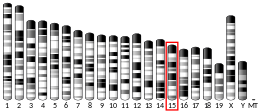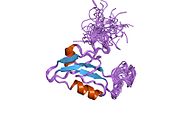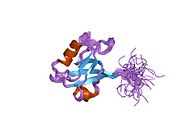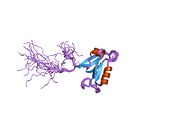SCRIB
SCRIB, also known as Scribble, SCRIBL, or Scribbled homolog (Drosophila), is a scaffold protein which in humans is encoded by the SCRIB gene.[5][6] It was originally isolated in Drosophila melanogaster in a pathway (also known as the Scribble complex) with DLGAP5 (Discs large) and LLGL1 (Lethal giant larvae) as a tumor suppressor.[7] In humans, SCRIB is found as a membrane protein and is involved in cell migration, cell polarity, and cell proliferation in epithelial cells.[7][8] There is also strong evidence that SCRIB may play a role in cancer progression because of its strong homology to the Drosophila protein.[7]
Function
[edit]In Drosophila melanogaster, SCRIB is involved in synaptic function, neuroblast differentiation, and epithelial polarization. Mechanistically, the human homolog is a scaffold protein linked to cellular differentiation centered on the regulation of epithelial as well as neuronal morphogenesis. Deficiency in SCRIB impairs many aspects of cell polarity and cell movement. SCRIB is also likely involved in establishing apical-basal polarity as well as progression from the G1 phase to S phase in the cell cycle as a result of its relationship with cell proliferation and exocytosis.[8]
The transcribed protein products of the SCRIB gene along with DLGAP5 (Discs large) and LLGL1 (Lethal giant larvae) are components of the Scribble complex that is localized in the basolateral membrane. The Scribble complex plays a role in determining cell polarity and cell proliferation in epithelial cells.[9] The precise mechanism by which these proteins function together is currently unknown, but they have been implicated in several signaling pathways, vesicle trafficking, and in the myosin II-actin cytoskeleton.[7] The Scribble complex has been shown to promote basolateral membrane identity by antagonizing both the Par complex and the Crumbs complex, which promote apical membrane identity.[9] These genes have also been identified as tumor suppressors in Drosophila melanogaster. Since these genes are highly conserved in humans, there is evidence that they play a role in cancer progression.[7]
Structure
[edit]The human homolog is a LAP protein, it contains 16 leucine-rich repeats and four PDZ domains.[10] SCRIB belongs to a protein complex containing betaPIX, an exchange factor for Rac/Cdc42, and GIT1, a GTPase activating protein for ARF6 implicated in receptor recycling and exocytosis.[11]
Subcellular and tissue distribution
[edit]SCRIB is found in the cell membrane most often as a peripheral membrane protein. The Scribble complex is localized at the basolateral membrane.[9] SCRIB is also found in cellular junctions such as adherens junctions and tight junctions.[12] Specifically, it is located in the kidney, skeletal muscles, liver, lung, breast, intestine, placenta and epithelial cells.[13]
Clinical significance
[edit]The PDZ domain of SCRIB binds directly to the human papillomavirus E6 protein.[14] SCRIB is targeted for ubiquitination by a complex of E6 and UBE3A and E6 induces degradation of SCRIB.[14]
Role as a tumor suppressor
[edit]As mentioned above, SCRIB has been identified as a tumor suppressor along with DLGAP5 (Discs large) and LLGL1 (Lethal giant larvae).[7] Specifically, SCRIB deficient mutants have been shown to promote the activity of numerous oncogenes.[9] For example, SCRIB is known to inhibit breast cancer formation and the depletion of SCRIB promotes neoplastic growth by disrupting morphogenesis and inhibiting cell death through an association with Myc.[9][15] In human cells expressing oncogenic Ras or Raf, it was found the loss of SCRIB resulted in the invasion of the extracellular matrix by various cell types. This is believed to be a direct result of regulation of the MAP Kinase pathway by SCRIB.[16]
Role in epithelial mesenchymal transition (EMT)
[edit]Due to its role in cell polarity and cell motility, SCRIB has also been implicated in epithelial mesenchymal transition (EMT), which is linked to tumor metastasis and proliferation in many cancers. EMT is implicated in cancer progression by allowing static epithelial cells to become migratory and allowing these cells to adapt to as well as colonize new environments. In cancerous epithelial tissues, SCRIB is found primarily in the cytosol as opposed to its usual location in the membrane, thus further implicating a role in tumor progression and EMT for SCRIB.[17]
Knockdown mutants have resulted in the loss of adhesion between Madin-Darby canine kidney epithelial cells. This loss of adhesion was correlated with an acquired mesenchymal appearance, an increase in motility, and loss of directionality. These effects were a direct result of the interruption of E-cadherin-mediated cellular adhesion.[18] A decrease in cell migration and an overall decrease in cell motility markers as well as epithelial mesenchymal transition mediators was also observed in small lung adenocarcinoma cells that were depleted of SCRIB.[17]
References
[edit]- ^ a b c ENSG00000180900 GRCh38: Ensembl release 89: ENSG00000274287, ENSG00000180900 – Ensembl, May 2017
- ^ a b c GRCm38: Ensembl release 89: ENSMUSG00000022568 – Ensembl, May 2017
- ^ "Human PubMed Reference:". National Center for Biotechnology Information, U.S. National Library of Medicine.
- ^ "Mouse PubMed Reference:". National Center for Biotechnology Information, U.S. National Library of Medicine.
- ^ "Entrez Gene: SCRIB scribbled homolog (Drosophila)".
- ^ Nagase T, Seki N, Tanaka A, Ishikawa K, Nomura N (August 1995). "Prediction of the coding sequences of unidentified human genes. IV. The coding sequences of 40 new genes (KIAA0121-KIAA0160) deduced by analysis of cDNA clones from human cell line KG-1". DNA Res. 2 (4): 167–74, 199–210. doi:10.1093/dnares/2.4.167. PMID 8590280.
- ^ a b c d e f Patrick Humbert; Sarah Russell; Helena Richardson (June 2003). "Dlg, Scribble and Lgl in cell polarity, cell proliferation and cancer". BioEssays. 25 (6): 542–53. doi:10.1002/bies.10286. PMID 12766944.
- ^ a b L E Dow; J S Kauffman; J Caddy; A S Peterson; S M Jane; S M Russell & P O Humbert (April 2007). "The tumour-suppressor Scribble dictates cell polarity during directed epithelial migration: regulation of Rho GTPase recruitment to the leading edge". Oncogene. 26 (16): 2272–82. doi:10.1038/sj.onc.1210016. PMID 17043654.
- ^ a b c d e Royer C, Lu X (September 2011). "Epithelial cell polarity: a major gatekeeper against cancer?". Cell Death Differ. 18 (9): 1470–7. doi:10.1038/cdd.2011.60. PMC 3178423. PMID 21617693.
- ^ Jennifer N. Murdoch; Deborah J. Henderson; Kit Doudney; Carles Gaston-Massuet; Helen M. Phillips; Caroline Paternotte; Ruth Arkell; Philip Stanier & Andrew J. Copp (November 2002). "Disruption of scribble (Scrb1) causes severe neural tube defects in the circletail mouse". Hum. Mol. Genet. 12 (2): 87–98. doi:10.1093/hmg/12.2.87. PMID 12499390.
- ^ Nola S, Sebbagh M, Marchetto S, Osmani N, Nourry C, Audebert S, Navarro C, Rachel R, Montcouquiol M, Sans N, Etienne-Manneville S, Borg JP, Santoni MJ (November 2008). "Scrib regulates PAK activity during the cell migration process". Hum. Mol. Genet. 17 (22): 3552–65. doi:10.1093/hmg/ddn248. PMID 18716323.
- ^ Petit MM, Meulemans SM, Alen P, Ayoubi TA, Jansen E, Van de Ven WJ (January 2005). "The tumor suppressor Scrib interacts with the zyxin-related protein LPP, which shuttles between cell adhesion sites and the nucleus". BMC Cell Biol. 6 (1): 1. doi:10.1186/1471-2121-6-1. PMC 546208. PMID 15649318.
- ^ Navarro C, Nola S, Audebert S, Santoni MJ, Arsanto JP, Ginestier C, Marchetto S, Jacquemier J, Isnardon D, Le Bivic A, Birnbaum D, Borg JP (June 2005). "Junctional recruitment of mammalian Scribble relies on E-cadherin engagement". Oncogene. 24 (27): 4330–9. doi:10.1038/sj.onc.1208632. PMID 15806148.
- ^ a b Nakagawa S, Huibregtse JM (November 2000). "Human scribble (Vartul) is targeted for ubiquitin-mediated degradation by the high-risk papillomavirus E6 proteins and the E6AP ubiquitin-protein ligase". Mol. Cell. Biol. 20 (21): 8244–53. doi:10.1128/MCB.20.21.8244-8253.2000. PMC 86433. PMID 11027293.
- ^ Zhan L, Rosenberg A, Bergami KC, Yu M, Xuan Z, Jaffe AB, Allred C, Muthuswamy SK (November 2008). "Deregulation of scribble promotes mammary tumorigenesis and reveals a role for cell polarity in carcinoma". Cell. 135 (5): 865–78. doi:10.1016/j.cell.2008.09.045. PMC 3015046. PMID 19041750.
- ^ L E Dow; I A Elsum; C L King; K M Kinross; H E Richardson & P O Humbert (July 2008). "Loss of human Scribble cooperates with H-Ras to promote cell invasion through deregulation of MAPK signalling". Oncogene. 27 (46): 5988–6001. doi:10.1038/onc.2008.219. PMID 18641685.
- ^ a b Valentina Vaira; Alice Faversani; Takehiko Dohi; Marco Maggioni; Mario Nosotti; Delfina Tosi; Dario C Altieri; Silvano Bosari (June 2011). "Aberrant Overexpression of the Cell Polarity Module Scribble in Human Cancer". The American Journal of Pathology. 178 (6): 2478–83. doi:10.1016/j.ajpath.2011.02.028. PMC 3124121. PMID 21549346.
- ^ Yi Qin; Christopher Capaldo; Barry M. Gumbiner & Ian G. Macara (December 2005). "The mammalian SCRIB polarity protein regulates epithelial cell adhesion and migration through E-cadherin". Journal of Cell Biology. 171 (6): 1061–71. doi:10.1083/jcb.200506094. PMC 2171311. PMID 16344308.
Further reading
[edit]- Nakajima D, Okazaki N, Yamakawa H, et al. (2003). "Construction of expression-ready cDNA clones for KIAA genes: manual curation of 330 KIAA cDNA clones". DNA Res. 9 (3): 99–106. doi:10.1093/dnares/9.3.99. PMID 12168954.
- Nagase T, Seki N, Tanaka A, et al. (1996). "Prediction of the coding sequences of unidentified human genes. IV. The coding sequences of 40 new genes (KIAA0121-KIAA0160) deduced by analysis of cDNA clones from human cell line KG-1". DNA Res. 2 (4): 167–74, 199–210. doi:10.1093/dnares/2.4.167. PMID 8590280.
- Nakagawa S, Huibregtse JM (2000). "Human scribble (Vartul) is targeted for ubiquitin-mediated degradation by the high-risk papillomavirus E6 proteins and the E6AP ubiquitin-protein ligase". Mol. Cell. Biol. 20 (21): 8244–53. doi:10.1128/MCB.20.21.8244-8253.2000. PMC 86433. PMID 11027293.
- Strausberg RL, Feingold EA, Grouse LH, et al. (2003). "Generation and initial analysis of more than 15,000 full-length human and mouse cDNA sequences". Proc. Natl. Acad. Sci. U.S.A. 99 (26): 16899–903. Bibcode:2002PNAS...9916899M. doi:10.1073/pnas.242603899. PMC 139241. PMID 12477932.
- Dow LE, Brumby AM, Muratore R, et al. (2004). "hScrib is a functional homologue of the Drosophila tumour suppressor Scribble". Oncogene. 22 (58): 9225–30. doi:10.1038/sj.onc.1207154. PMID 14681682.
- Nakagawa S, Yano T, Nakagawa K, et al. (2004). "Analysis of the expression and localisation of a LAP protein, human scribble, in the normal and neoplastic epithelium of uterine cervix". Br. J. Cancer. 90 (1): 194–9. doi:10.1038/sj.bjc.6601465. PMC 2395302. PMID 14710229.
- Bouwmeester T, Bauch A, Ruffner H, et al. (2004). "A physical and functional map of the human TNF-alpha/NF-kappa B signal transduction pathway". Nat. Cell Biol. 6 (2): 97–105. doi:10.1038/ncb1086. PMID 14743216. S2CID 11683986.
- Brill LM, Salomon AR, Ficarro SB, et al. (2004). "Robust phosphoproteomic profiling of tyrosine phosphorylation sites from human T cells using immobilized metal affinity chromatography and tandem mass spectrometry". Anal. Chem. 76 (10): 2763–72. doi:10.1021/ac035352d. PMID 15144186.
- Lehner B, Sanderson CM (2004). "A protein interaction framework for human mRNA degradation". Genome Res. 14 (7): 1315–23. doi:10.1101/gr.2122004. PMC 442147. PMID 15231747.
- Borg JP (2004). "[hScrib: a potential novel tumor suppressor]". Pathol. Biol. 52 (6): 328–31. doi:10.1016/j.patbio.2003.09.015. PMID 15261375.
- Beausoleil SA, Jedrychowski M, Schwartz D, et al. (2004). "Large-scale characterization of HeLa cell nuclear phosphoproteins". Proc. Natl. Acad. Sci. U.S.A. 101 (33): 12130–5. Bibcode:2004PNAS..10112130B. doi:10.1073/pnas.0404720101. PMC 514446. PMID 15302935.
- Ballif BA, Villén J, Beausoleil SA, et al. (2005). "Phosphoproteomic analysis of the developing mouse brain". Mol. Cell. Proteomics. 3 (11): 1093–101. doi:10.1074/mcp.M400085-MCP200. PMID 15345747.
- Gerhard DS, Wagner L, Feingold EA, et al. (2004). "The status, quality, and expansion of the NIH full-length cDNA project: the Mammalian Gene Collection (MGC)". Genome Res. 14 (10B): 2121–7. doi:10.1101/gr.2596504. PMC 528928. PMID 15489334.
- Petit MM, Meulemans SM, Alen P, et al. (2006). "The tumor suppressor Scrib interacts with the zyxin-related protein LPP, which shuttles between cell adhesion sites and the nucleus". BMC Cell Biol. 6 (1): 1. doi:10.1186/1471-2121-6-1. PMC 546208. PMID 15649318.
- Barrios-Rodiles M, Brown KR, Ozdamar B, et al. (2005). "High-throughput mapping of a dynamic signaling network in mammalian cells". Science. 307 (5715): 1621–5. Bibcode:2005Sci...307.1621B. doi:10.1126/science.1105776. PMID 15761153. S2CID 39457788.
- Lahuna O, Quellari M, Achard C, et al. (2005). "Thyrotropin receptor trafficking relies on the hScrib-betaPIX-GIT1-ARF6 pathway". EMBO J. 24 (7): 1364–74. doi:10.1038/sj.emboj.7600616. PMC 1142541. PMID 15775968.
- Navarro C, Nola S, Audebert S, et al. (2005). "Junctional recruitment of mammalian Scribble relies on E-cadherin engagement". Oncogene. 24 (27): 4330–9. doi:10.1038/sj.onc.1208632. PMID 15806148.
- Métais JY, Navarro C, Santoni MJ, et al. (2005). "hScrib interacts with ZO-2 at the cell-cell junctions of epithelial cells". FEBS Lett. 579 (17): 3725–30. doi:10.1016/j.febslet.2005.05.062. PMID 15975580. S2CID 4893407.
- Thomas M, Massimi P, Navarro C, et al. (2005). "The hScrib/Dlg apico-basal control complex is differentially targeted by HPV-16 and HPV-18 E6 proteins". Oncogene. 24 (41): 6222–30. doi:10.1038/sj.onc.1208757. PMID 16103886.









